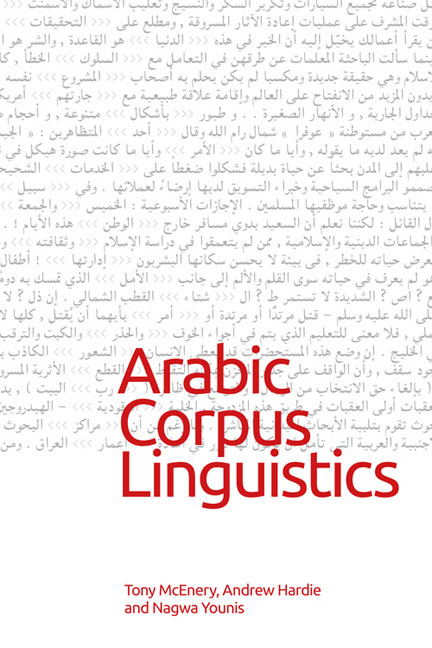Book contents
- Frontmatter
- Contents
- Notes on Contributors
- 1 Introducing Arabic Corpus Linguistics
- 2 Under the Hood of arabiCorpus
- 3 Tunisian Arabic Corpus: Creating a Written Corpus of an ‘Unwritten’ Language
- 4 Accessible Corpus Annotation for Arabic
- 5 The Leeds Arabic Discourse Treebank: Guidelines for Annotating Discourse Connectives and Relations
- 6 Using the Web to Model Modern and Qurʾanic Arabic
- 7 Semantic Prosody as a Tool for Translating Prepositions in the Holy Qurʾan: A Corpus-Based Analysis
- 8 A Relational Approach to Modern Literary Arabic Conditional Clauses
- 9 Quantitative Approaches to Analysing come Constructions in Modern Standard Arabic
- 10 Approaching Text Typology through Cluster Analysis in Arabic
- Appendix: Arabic Transliteration Systems Used in This Book
- Index
4 - Accessible Corpus Annotation for Arabic
Published online by Cambridge University Press: 11 November 2020
- Frontmatter
- Contents
- Notes on Contributors
- 1 Introducing Arabic Corpus Linguistics
- 2 Under the Hood of arabiCorpus
- 3 Tunisian Arabic Corpus: Creating a Written Corpus of an ‘Unwritten’ Language
- 4 Accessible Corpus Annotation for Arabic
- 5 The Leeds Arabic Discourse Treebank: Guidelines for Annotating Discourse Connectives and Relations
- 6 Using the Web to Model Modern and Qurʾanic Arabic
- 7 Semantic Prosody as a Tool for Translating Prepositions in the Holy Qurʾan: A Corpus-Based Analysis
- 8 A Relational Approach to Modern Literary Arabic Conditional Clauses
- 9 Quantitative Approaches to Analysing come Constructions in Modern Standard Arabic
- 10 Approaching Text Typology through Cluster Analysis in Arabic
- Appendix: Arabic Transliteration Systems Used in This Book
- Index
Summary
Introduction
In this chapter, we introduce a process for making the highly complex output of morphosyntactic analysis software for Arabic usable and accessible within a framework that is familiar to (corpus) linguists with minimal technical expertise. Our argument is organised as follows. After a brief exposition of the key premise of our work (section 2), we move on to a review of some of the schemata and systems that have been devised and distributed in recent years for the morphological and/or morphosyntactic annotation of Arabic text (section 3). In section 4, we move on to build an argument for why a new formulation of the output of systems such as those reviewed is necessary for reasons of usability and accessibility within widely used corpus query tools. (Since one of the present authors is the developer of the CQPweb software – see Hardie 2012 – we will refer mainly to CQPweb here.) Our actual implementation of this goal, a system which postprocesses the output of the MADA software (discussed in section 2), is outlined in section 5. Finally, we outline briefly the avenues for further work that this accessible corpus annotation opens up (section 6).
The nature of POS tagging in Arabic
In light of the fact that morphology rather than syntax is the locus of much of Arabic's structural complexity (see overview in McEnery et al., this volume), it is perhaps unsurprising that in much computational work on the grammatical analysis of Arabic, morphological considerations have been extremely prominent. In languages such as English, the definitions of morphosyntactic categories for POS tagging rely as often on syntactic criteria as morphological criteria – for instance, the difference between infinitives and present tense in English is entirely syntax-driven, as there is no morphological distinction. For Arabic, by contrast, it has often been the case that POS tagging has not been fully distinguished from morphological analysis: as we will see in the review that follows, Arabic POS tagsets often classify morphemes rather than words, and Arabic POS taggers likewise often undertake full morphological analysis rather than simply applying a single tag to each word.
- Type
- Chapter
- Information
- Arabic Corpus Linguistics , pp. 56 - 75Publisher: Edinburgh University PressPrint publication year: 2018



